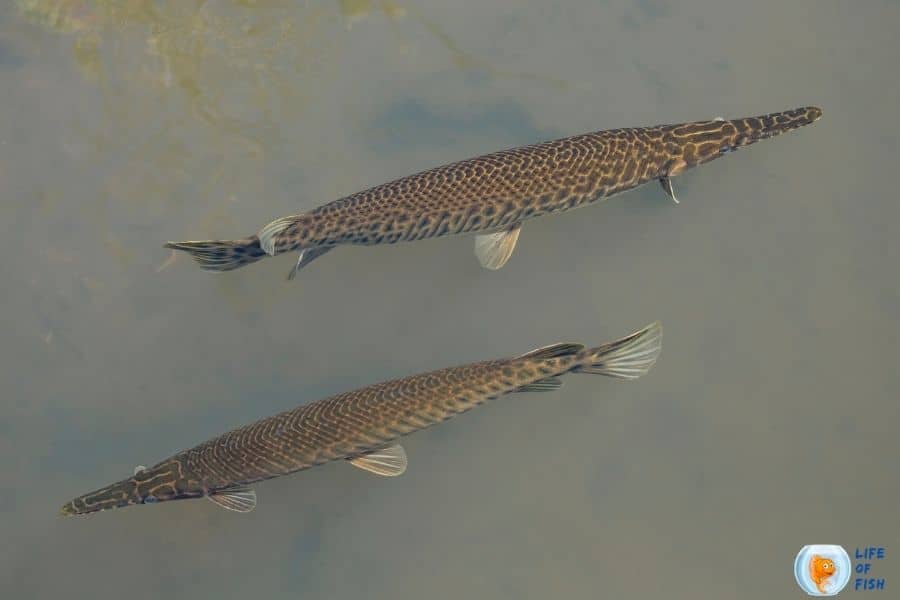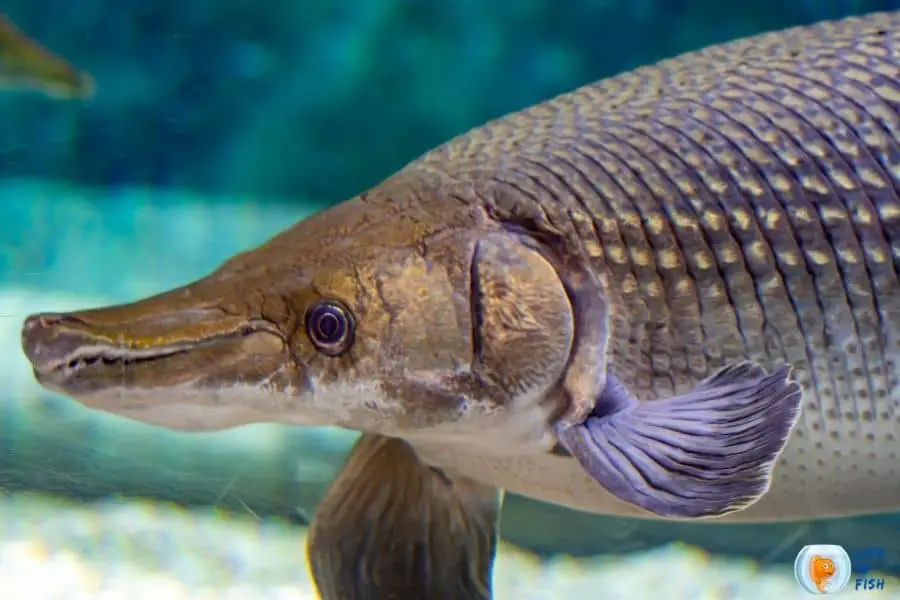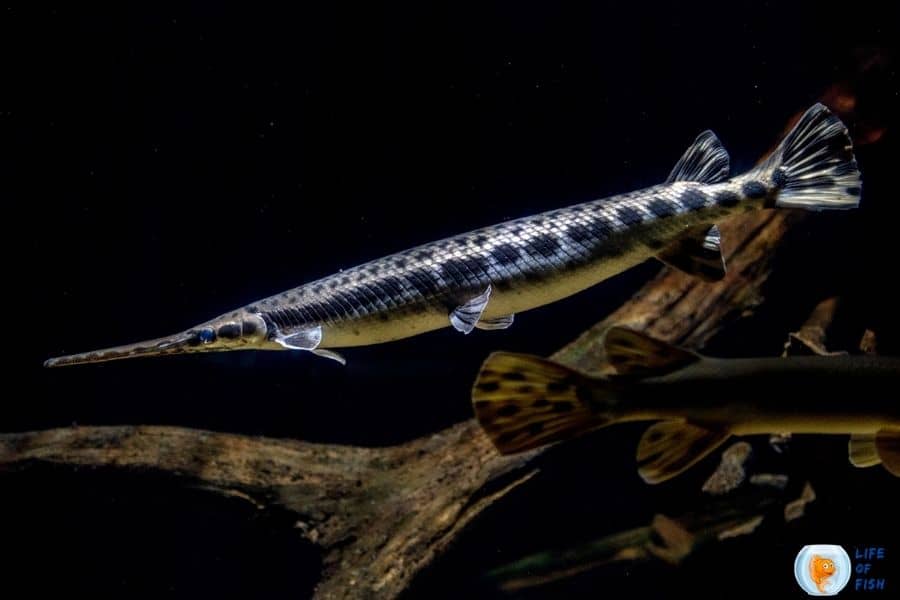Besides being the “Alligator Fish”, they are not dangerous like Alligators. But because of their size, humans consider them dangerous. In this article, we specifically talk about Alligator gar size in the wild, in captivity, and more interesting facts about these massive-sized fish.
Alligator gar (Atractosteus spatula), is the second-largest freshwater fish native to the U.S., found in reservoirs, lakes, brackish waters of estuaries, bayous, and bays in the Southern United States.
It is the biggest gar species and has a history of over 100 million years.
They are very different from other fish because they have thick elongated bodies and long snouts with conical-shaped teeth in their jaws.
The head is Alligator-shaped, hence they are named Alligator fish.

Alligator gar max size
Jump To
Alligator gar average lengths are 5 to 6 feet (1.5 to 1.8 m), but the largest alligator gar ever caught was 8 feet and 5 1/4 inches (2.572 meters) long, weighing 327 pounds (148 kg).
The oldest recorded alligator gar was almost 95 years old. However, according to anecdotal reports, these fish can grow up to 10 feet (3 m) and weigh 350 pounds (159 kg).
Alligator gar size in captivity
Growing up in captivity doesn’t stop them from reaching their tremendous sizes. Although they will show stunted growth in captivity, these fish take years to reach their maximum size.
For example, about 5 to 6 feet alligator gars are about 15 years old while a 7 feet fish is as old as 40 years.
According to the records the largest alligator gar caught in Louisiana in 2002. It was 215lb in weight.
The question is, will the owner live that long to see their maximum growth size? And will anyone keep a fish that long in captivity, unless it is a public aquarium?
However, if you happen to keep an Alligator gar in captivity, you will have to provide at least 40 feet (12.192m) long and 20 feet (6.096m) wide aquarium or pond for them to thrive.
Otherwise, you will have to give it away or make arrangements to release it back into the wild, if it is a local fish.
What is the giant alligator gar?
There are no smaller species of Alligator gar, but there are other species that are closely related to Alligator gar, with similar characteristics, although they are smaller in their mature size.
For example, the Shortnose gar (Atractosteus oxyrhinchus) is a smaller fish usually reaching lengths of 2 to 3 feet.
People often call Atractosteus spatula the Alligator Gar because this giant fish can grow as big as 10 feet (3 m) long weighing up to 350 pounds (159 kg).
Atractosteus spatula is the biggest fish species in the gar family and the second-largest freshwater fish in North America.
How big do alligator gar get in Texas?
Alligator gar in Texas reaches the same length and weight in the wild. Why people often ask this question is because there are no size restrictions to capture these fish in this state.
The only restriction is that you can catch only one Alligator gar in this state, except for Falcon reservoir, where you can catch up to 5 fish.
So, whether you catch a 3 feet gar or a whopping 10 feet gar, no one will bother you with the law.
Alligator gar appearance
Alligator gar is a mega fish species, with long cylindrical bodies that are covered in tough scales which have sharp edges.
These scales are much larger than other fish species, covering their whole body except for the soft underbelly.
Alligator gar have large broadheads with very big jaws containing conical teeth in both jaws.
Alligator gar has no pelvic fins and the dorsal and pectoral fins are located far back on the body. The dorsal fin is small with 37 – 44 rays; whereas, the anal fin has 15 – 18 rays.
The color is olive-brown and their white bellies are covered with scar-like markings because their armor-like scales are rough to the touch.
Alligator gar has no distinct patterns on their bodies, but you can notice the faint light band that runs from behind its head to the end of its tail.

lifespan of Alligator Gar
Alligator gars live around 50 to 70 years on average and adult alligator gar can reach about 10 feet (3 m) in length. However, some larger individuals live like 95 years.
What do they eat?
Alligator gars are carnivore species and have few natural predators. They feed on fish, turtles, snakes, frogs, blue crabs and small mammals.
Their diet also depends on the size of the gar. Juveniles will eat smaller prey items in comparison with older ones.
The biggest alligator gar eats other fishes, turtles and anything that enters their mouths, like snakes and small birds.
Alligator gar mostly hunt during the night and early morning hours and will often stay dormant in the shade during the day.
Alligator gar are solitary fish that appear to be very passive, but they are voracious ambush predators.
They lie in the water bodies under the sun or shade, waiting for their prey to come close. Their huge jaws allow them to swallow their prey whole.
Their teeth are conical and sharp, designed for holding onto prey while cutting it into smaller parts with a backward motion of its head.
Once they get hold of something, it is very hard to get it off their mouths.
The gar has an acute sense of smell, excellent eyesight and the ability to sense the slightest vibration in the water using its lateral line system.
Alligator gars are aggressive hunters that can devour 30% of their own body weight at a single time.
That’s more than 70 pounds! They are responsible for many snake and alligator fatalities.
Read More: Do Freshwater Parrotfish Eat Plants?| With Parrot Fish Feeding Behaviour|
habitat and distribution
The native range of Alligator gar is in eastern Texas and southeastern Oklahoma to Mobile Bay, Alabama and Florida.
Alligator gar normally lives in the waters of rivers, lakes and coastal marshes. They prefer clear water with rocky or sandy bottoms where they can easily ambush their prey.
Juvenile alligator gars prefer shallow ponds, creeks and bayous that provide them shelter from predators.
As you know, they live for more than 50 years, so it is very important for them to protect themselves from enemies.
Alligator gar lives in fresh and brackish water bodies all over southern portions of the United States and they are abundant in Texas.
Alligator gars live mainly in areas with calm waters and their main food source is fish, so they usually live close to the shores.
But don’t be fooled by their location, because alligator gars can swim as much as 60 miles during warmer months.
Alligator gar reproduction
The spawning of alligator gars begins when the water temperature is around 82° F (28° C) and ends when it reaches 55° F (13° C).
During late spring, adult Alligator gars become ready to spawn. The spawning of these species triggers when rivers are flooded, the water temperature rises and when their habitats are covered with dense vegetation.
The mating behavior includes a ritual of touching jaws while swimming in circles around each other.
The spawning season begins when the water level starts going down after flooding seasons.
The mating ritual triggers the female to release eggs in the water column and at the same time the male gar releases clouds of sperm to fertilize the eggs.
The sticky eggs then attach to aquatic plants, where their development begins. It only takes a few days for the eggs to hatch into larval fish, then another 10 days or so for the fish fry to separate from the vegetation and begin moving around as free-swimming fry.
The spawning continues until late summer or early fall, depending on water temperature and available sunlight exposure.
Alligator gars are polygamous fish and a single female can lay up to 150,000 eggs per spawn. This mating ritual continues for about 2 weeks, with the spawning occurring over a few days.
Juveniles appear to remain in spawning sites as they grow, with sexual maturity occurring between the ages of 10 and 14 years.
Despite the fact that baby fish grow exceedingly quickly, they have a lifespan of more than 30 years. Alligator gars usually start producing eggs at around 17 years old.

Recently Asked Questions
Is gar aggressive?
Alligator gar species are aggressive fish species as they are carnivores. However, they are somewhat passive as they grow bigger.
In captivity, these fish become aggressive only when there is not enough food supply or if their tank size is too small.
If you never leave an Alligator gar hungry in your aquarium, they probably will not attack other fish.
Can a gar bite you?
Alligator gars have large mouths and sharp teeth that can harm humans seriously. Their mouths and teeth evolved for eating large prey, like turtles and snakes.
However, there are no documented cases of Alligator gars attacking humans. Even if you try to touch a gar, they will probably get scared and escape your hand.
The only time they may bite or attack you is when you catch these fish out of water or if you are trying to catch one for food.
Then they may get afraid and feel threatened and bite you in self-defense, but this is highly unlikely.
Are alligator gar protected?
Alligator gars are protected by law in the USA. Alligator gar are native to North America and they live in waters of the Gulf of Mexico, Mississippi River Basin including some tributaries like Missouri River Basin (Missouri, Kansas, Oklahoma) and also Ohio River Basin (Ohio).
Due to their undeserved reputation as “trash fish”, anglers used to cull them in the 20th century to save the other “game fish” and nets.
However, recently biologists proved that Alligator gars do not pose threat to other fishes and they are also an important part of aquatic ecosystems.
Now it has become a popular sport fish for anglers, especially for bow fishers. In texas Alligator, gar caught using a rod and reel.
However, to establish these species again in their natural habitats, experts had to reintroduce them in some states where they were previously extinct.
Therefore, to control the fishing and to stabilize the Alligator gar population, local authorities have to issue limited harvest permits.
Conclusion
Alligator gar is probably the largest freshwater fish you can find. These fish can grow up to 10 feet (3 m) and weigh 350 pounds (159 kg) both in the wild and in captivity.
They are also native to USA, so they are protected by law.
These fish are very rare and because of that big mouth and sharp teeth it is highly advised not to try handling them or catch them with bare hands, but use long fishing rods with large reels.
Although there were known as trash fish before they are now known as valuable fish.
Read More: What does Alligator Gar Eat? | 14 Crazy Facts About Alligator Gars |
